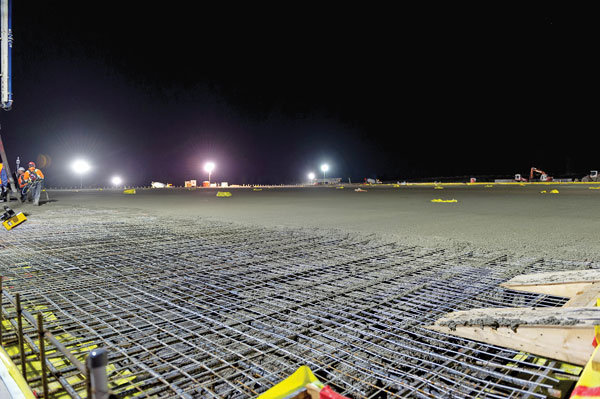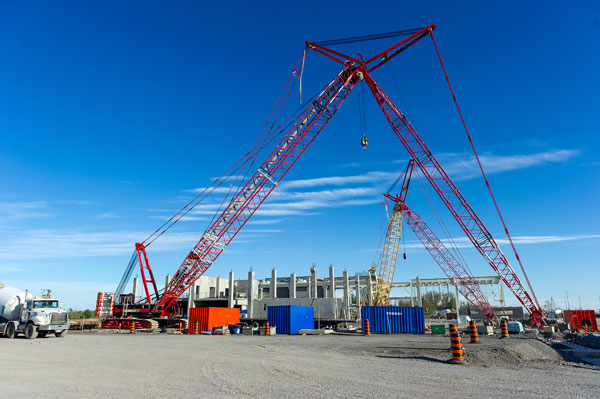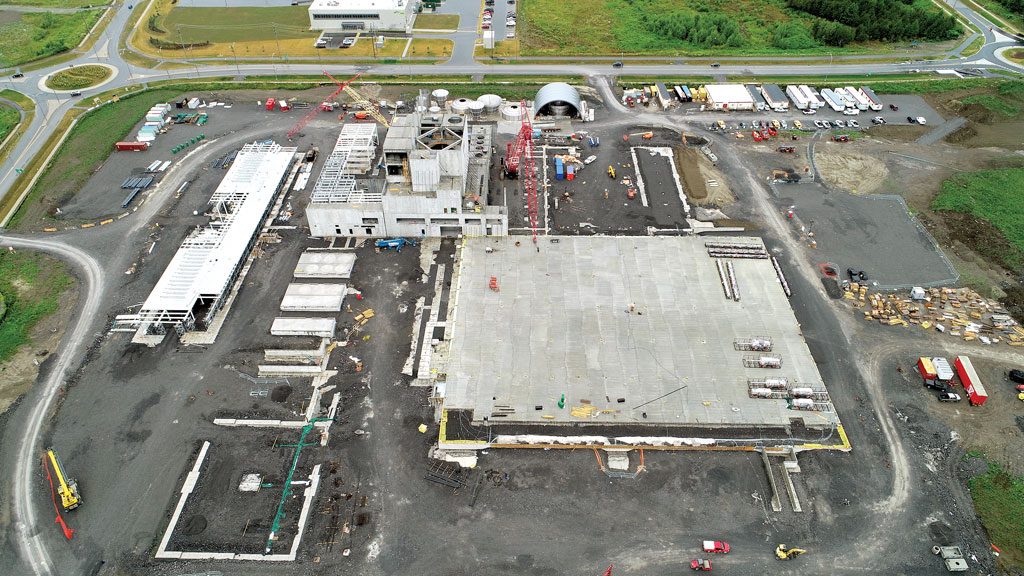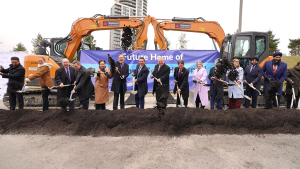The largest continuous concrete pour in the history of Graham Construction and the City of Kingston, Ont. took place at the Canada Royal Milk project site recently, with almost 22 million pounds of concrete poured over 9,400 square metres in a span of 20 hours.
“There was absolutely no stoppage,” said Daniel Balazs, a project director for Graham Construction. “Little details that people don’t think about when you are pouring concrete is buying food and water for the people that are working there, having washrooms, making sure they can get a break, standby equipment, maintenance.”
Once complete, the Canada Royal Milk project, a $200 million design, build, service contract, will be a 320,000-square-foot infant formula facility and North America’s first and only goat milk infant formula facility. The client is a Chinese company, the third biggest baby formula manufacturer in the world. The project is expected to be complete in the second quarter of 2019.
Pouring started at 6 a.m. with over 50 trucks making 476 trips between four concrete plants and pouring about 4,289 cubic metres of concrete in a 20-hour period at an average of about 234 cubic metres an hour. The pour required collaboration by all trade partners and stakeholders on the project. The team estimated the pour would take between 18 and 24 hours.
“There was about four months of planning where we had a meeting biweekly with all of the major stakeholders and went through safety, redundancy on the concrete plants, logistics, staffing, equipment requirements — we basically discussed everything in detail for what would be required for that pour,” explained Jason Bonter, construction manager on the project, who was instrumental in planning the pour.

Trade partners on the project included Northfleet Concrete Flooring, Gordon Barr Ltd., Modern Niagara, Alliance Forming Ltd., Kimco Steel and Verdi Alliance. The concrete supplier was Lafarge Canada, which developed a contingency plan that included two back-up plants and a standby fleet with truck maintenance personnel. J.L. Richards and Cambium ensured compliance with the design requirements.
A continuous pour of this size saves time and prevents quality issues, explained Bonter of the reason behind the plan.
“I was concerned about transference and cracks between the base slab and the topping after the fact so pouring it as all one big raft made more sense to me as far as quality,” explained Bonter. “It saved a lot of time because if I was to break it up into smaller pours you would have had bulkheads, a bunch of extra work, you would have had to wait for areas to be complete. It would have taken a lot of extra time in the schedule as opposed to getting it all prepped and pouring it in one large pour.”
Safety was a top priority during the planning process and a number of items were identified during a detailed risk assessment including drive-through wash-out pits to eliminate concrete trucks from backing out without signal men, structural wire mesh on the slab, lighting plans and traffic flow plans.
During the pour, a controller at the gate directed the concrete trucks where to go. The pumps were stationery and the trucks backed up to the pumps, dumped the concrete in and the pumps had rotating heads that poured the concrete to form the slab.

Placing and finishing equipment reduced the number of placers as well as the potential of repetitive stress injuries by using power rigs and power screeds, eliminating almost all the raking, hand screeding and shovelling required by traditional placing, states a video of the pour issued by Graham.
“There was a structural steel wire mesh that was installed on the slab for two reasons: first of all for safety and to make sure nobody fell through the rebar and to drive the placing equipment on top of it, also reducing the risk of repetitive stress injury,” Bonter said.
Most of the pour went according to plan with no safety incidents, no rejected concrete and 100 per cent compliance on all break tests for concrete strength but that doesn’t mean there weren’t some challenges.
“We had one pump breakdown and we had one plant breakdown,” said Bonter.
“On large pours like this you have to have backups, so if you need three pumps you have four, if you need three plants you have four. We had four concrete plants and we did have one of them go down for about 25 minutes, but of course in our plan we also had maintenance staff at each plant able to fix it if it went down.”
A four-inch topping will be poured on the slab in October or November. It needs to be a completely flat slab because the facility will be using a robotic storage and retrieval system.
“When these robots reach up to store and retrieve products, any unevenness in the floor is a great deviation on the top which is 100 feet in the air, so the floor has to be absolutely flat,” explained Balazs.
“We don’t want any cracking in the floor, any shrinkage, so we have done a bunch of consultations with the concrete designers.”










Recent Comments
comments for this post are closed